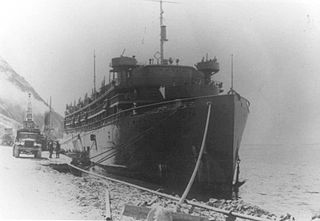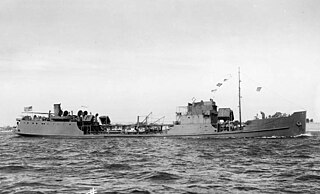
The Chesapeake & Delaware Canal is a 14-mile (22.5 km)-long, 450-foot (137.2 m)-wide and 35-foot (10.7 m)-deep ship canal that connects the Delaware River with the Chesapeake Bay in the states of Delaware and Maryland in the United States. The C&D Canal is owned and operated by the U.S. Army Corps of Engineers, Philadelphia District. The project office in Chesapeake City, Maryland, is also the site of the C&D Canal Museum and Bethel Bridge Lighthouse. The canal saves approximately 300 miles on the route between Wilmington and Baltimore, and similar for Philadelphia to Baltimore, whereas otherwise ships would have to go around the lower peninsula of Delaware.

Dorchester was a coastal passenger steamship requisitioned and operated by the War Shipping Administration (WSA) in January 1942 for wartime use as a troop ship allocated to United States Army requirements. The ship was operated for WSA by its agent Atlantic, Gulf & West Indies Steamship Lines (Agwilines). The ship was in convoy SG 19 from New York to Greenland transiting the Labrador Sea when it was torpedoed by a German U-boat on February 3, 1943. The ship sank with loss of 674 of the 904 on board with one of the 230 survivors lost after rescue. The story of four Army chaplains, known as the "Four Chaplains" or the "Immortal Chaplains," who all gave away their life jackets to save others before they died, gained fame and led to many memorials.

USS Charger (CVE-30) was an escort carrier of the United States Navy during World War II converted from a commercial C3-P&C cargo/passenger liner hull built as Rio de la Plata intended for the Moore-McCormack company's American Republics Line serving the east coast of South America. The ship was requisitioned for conversion to an escort carrier type intended for Royal Navy use and initially commissioned as HMS Charger (D27). Days later the transfer was rescinded with the ship returning to U.S. Navy control to become USS Charger which operated throughout the war as a training ship on the Chesapeake Bay with two ferry missions to Bermuda and Guantánamo Bay, Cuba.

SS John W. Brown is a Liberty ship, one of two still operational and one of three preserved as museum ships. As a Liberty ship, she operated as a merchant ship of the United States Merchant Marine during World War II and later was a vocational high school training ship in New York City for many years. Now preserved, she is a museum ship and cruise ship berthed at Clinton Street Pier 1 in Baltimore Harbor in Maryland.

USS Aquamarine (PYc-7) was the former yacht Siele launched in April 1926 by Pusey and Jones Corporation, Wilmington, Delaware. In 1940 Siele was sold and renamed Sea Wolf which was purchased by the Navy in January 1941 and commissioned Aquamarine in April. Though given a "patrol yacht, coastal" designation the yacht was assigned to the Naval Research Laboratory for acoustical research during World War II. After naval service the yacht was again under the name Sea Wolf until sold in 1954 and renamed Miss Ann, listed on the U.S. National Register of Historic Places in 1998.

USS Refuge (AH-11), was a hospital ship of the United States Navy during World War II. The ship was built in 1921 by the New York Shipbuilding Corp., of Camden, New Jersey, as SS Blue Hen State, but was renamed President Garfield in 1923 and then SS President Madison in 1940 for service with American President Lines. Acquired by the Navy from the War Shipping Administration on 11 April 1942 the ship was commissioned as the transport USS Kenmore until conversion to a hospital ship.

USS Monadnock (ACM-10) was a coastal minelayer in the U.S. Navy, the third vessel named after a civil war monitor, USS Monadnock (1863) named after Mount Monadnock. The ship was built as the cargo vessel Cavalier for the Philadelphia and Norfolk Steamship Company by Pusey and Jones Corporation, Wilmington, Delaware in 1938. The Navy purchased the ship 9 June 1941 for wartime use. After decommissioning the ship was sold in June 1947 for commercial use then sold to a Panamanian company in 1949 to be renamed Karukara. In 1952 the ship became Monte de la Esperanza for a company in Bilboa, Spain transporting bananas to the United Kingdom from the Canary Islands for more than 20 years. She was later sold to the Marine Institute of Spain for operation as a hospital ship for more than 10 years serving the fishing fleet of the Canary Islands as Esperanza del Mar until becoming an artificial reef off Spain in 2000.

USS Miantonomah (CM-10/CMc-5) was built as SS Quaker by Pusey & Jones Corporation, Wilmington, Delaware in 1938 as a commercial coastwise ship operating as a fast inland water passenger and freight carrier. Quaker was acquired by the Navy in May 1941 for conversion to a coastal minelayer. Miantonomah operated off the east coast of the United States, Africa and the Mediterranean and took part in the invasion of Europe in 1944. The ship was sunk by a mine 25 June 1944.

USS Guyandot (AOG-16) was a gasoline tanker acquired by the U.S. Navy as Veedol No. 2 from Tidewater Oil to serve as a gasoline tanker. The tanker served in Mediterranean operations often under air attack. After postwar decommissioning January 1945 in Algeria and service with the French under lend-lease the tanker was purchased in March 1949 by France serving under the name Lac Noir.

Pan Kraft was a cargo ship built in 1919 by the Western Pipe and Steel Company of California. She was one of eighteen ships built by the company for the U.S. Shipping Board. After merchant service between the wars, she was to become one of the victims of Great Britain's disastrous Convoy PQ 17 to Russia during World War II.

The Baltimore Steam Packet Company, nicknamed the Old Bay Line, was an American steamship line from 1840 to 1962 that provided overnight steamboat service on the Chesapeake Bay, primarily between Baltimore, Maryland, and Norfolk, Virginia. Called a "packet" for the mail packets carried on government mail contracts, the term in the 19th century came to mean a steamer line operating on a regular, fixed daily schedule between two or more cities. When it closed in 1962 after 122 years of existence, it was the last surviving overnight steamship passenger service in the United States.

USS Crystal (PY-25), built in 1929 as the yacht Cambriona for Walter O. Briggs of Detroit, Michigan, was a patrol yacht in the United States Navy. The Navy acquired the yacht in January 1942 as Vida commissioning the vessel as Crystal in February. Naval service was in Hawaii until November 1945. After sale in November 1947 the vessel operated commercially in Central and South America.
The Pusey and Jones Corporation was a major shipbuilder and industrial-equipment manufacturer. Based in Wilmington, Delaware, it operated from 1848 to 1959.

USS Zircon (PY-16) was the private yacht Nakhoda acquired by the United States Navy in 1940 serving as an armed yacht from 1941 to 1946. The yacht Nakhoda was built for automobile executive Frederick J. Fisher by Pusey and Jones Corporation, Wilmington, Delaware delivered in 1930. After the war the yacht was sold and reverted to the original name until sold in 1951 to the United New York Sandy Hook Pilots Association and renamed New York.
SS President Taft was launched as one of the "state" ships, Buckeye State, completed by the United States Shipping Board as cargo passenger ships after originally being laid down as troop transports. Buckeye State had been laid down as Bertrice but was converted and renamed before launching. Originally assigned to the Matson Navigation Company as the Shipping Board's agent, the ship was later renamed President Taft and assigned to Pacific Mail Steamship Company for operation. In 1925 the Shipping Board sold the ship to Dollar Steamship Company. President Taft was operated by Dollar and then its successor American President Lines until requisitioned by the War Department on 17 June 1941.

USS Siren (PY-13), briefly CMc-1, was built by Pusey and Jones, Wilmington, Delaware and launched 15 November 1929 as the yacht Lotosland. The yacht was acquired by the United States Navy in October 1940 and placed in commission as a Patrol Yacht from 1940 to 1946.

Corvus was a steam cargo ship built in 1919 by Columbia River Shipbuilding Company of Portland for the United States Shipping Board as part of the wartime shipbuilding program of the Emergency Fleet Corporation (EFC) to restore the nation's Merchant Marine. The freighter was operated on international and domestic routes through 1944. Early in 1945 she was transferred to Soviet Union as part of lend-lease program. After several months of operation, the freighter was rammed by another vessel on 31 May 1945 and was beached to avoid sinking. She was subsequently raised and towed to Portland where she was scrapped in 1946.

The Delaware Railroad was the major railroad in the US state of Delaware, traversing almost the entire state north to south. It was planned in 1836 and built in the 1850s. It began in Porter and was extended south through Dover, Seaford and finally reached Delmar on the border of Maryland in 1859. Although operated independently, in 1857 it was leased by and under the financial control of the Philadelphia, Wilmington, and Baltimore Railroad. In 1891, it was extended north approximately 14 miles (23 km) with the purchase of existing track to New Castle and Wilmington. With this additional track, the total length was 95.2 miles (153.2 km).

Mohawk was a steam passenger ship built in 1908 by William Cramp & Sons of Philadelphia for Clyde Steamship Company with intention of operating between New England and southern ports of the United States. In early January 1925 the ship caught fire off New Jersey coast and eventually was abandoned and scuttled by the crew without a loss of life.

Cokesit was a steam cargo ship built in 1918–1919 by Guy M. Standifer Construction Company of Vancouver for the United States Shipping Board as part of the wartime shipbuilding program of the Emergency Fleet Corporation (EFC) to restore the nation's Merchant Marine. The vessel was largely employed on the East Coast of the United States to Australia route until 1928 when she was laid up. In late 1937 the ship together with several other vessels was bid on and subsequently acquired next year by the Greek tramp operator John D. Chandris to carry cargo from Australia to Greece and United Kingdom. The freighter was also renamed Adelfoi Chandris. Following the surrender of France, the ship was interned in Dakar and passed into Vichy government hands in 1940 and renamed Saint Marin. Under the terms of Nevers Agreement she eventually was transferred to Italy and renamed Catania. In early August 1943 the vessel together with several other ships was bombed and damaged in Naples harbor by the Allied aircraft.

















